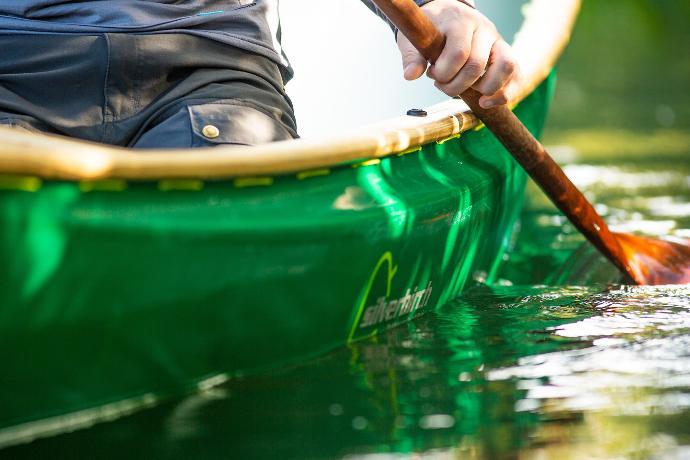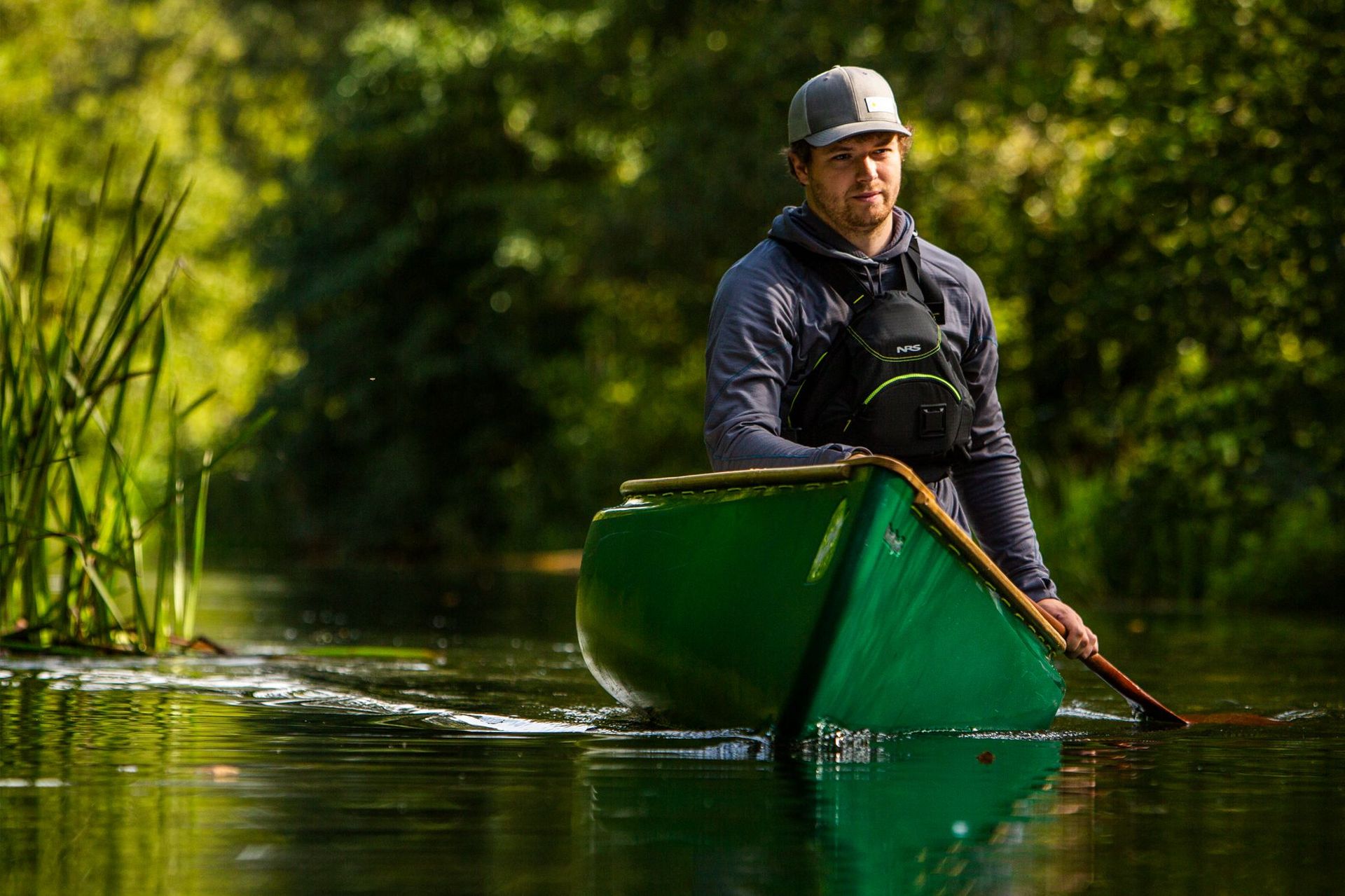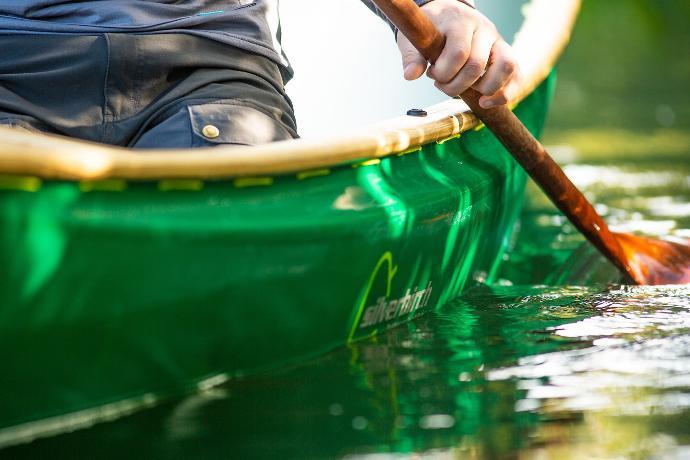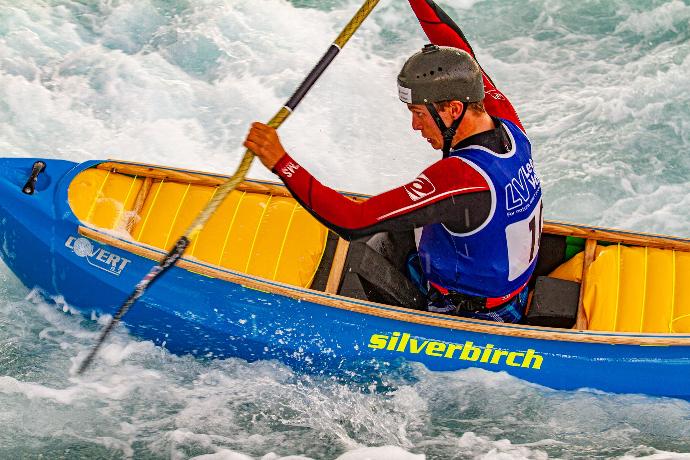No traditional canoe needs a seat, and seats are not traditional in all canoes… but choice of seating can make a huge difference to the look and feel of a canoe, and to how we feel comfortable using the canoe.
SEATS IN TRADITIONAL CANOES
Some prefer to stand, kneel, squat on cushions, or to perch on one of the gunwales, and we find just as much variety in canoeist seating preferences: from bench seats to tractor seats and from bucket seats to saddles.
As a rule, we have a choice over how many seats to fit, and over where to fit them. Solo canoes can be adapted as ultra-compact tandems. Tandems can often be set up with an additional centre seat, or just with a solo seat.
Of course, once we've chosen our seats, we also need to decide how far forward/back to fit them, and how high off the floor… or we need to decide how we're going to experiment to get our preferred position.

In Part I, we looked at trim levels in a canoe, from lowline, standard and highline to gunwale choices. After this consideration of canoe seats: components which can be swapped but which are typically left unchanged for the life of a canoe. Part III will move on to thwarts, including sailing thwarts and kneeling thwarts.
Canoes destined for hire-fleets may be fitted with Polyethylene seats: a robust solution which might be expected to last the lifetime of the canoe. Manufacturers may offer a single configuration (e.g. two seats in a pocket tandem) or multiple configurations (e.g. two, three or four seats in a 5.2m (17') canoe. Height and fore/aft positioning is unlikely to be easily customised.

POSITIONING STANDARD BENCH SEATS
For shear versatility, no-one has ever really beaten a standard cane or wood web seat, mounted horizontally and high enough off the floor of the canoe to allow sitting or kneeling.
If we have no other, over-riding concern, our positioning of TANDEM canoe seats might be to give each paddler the most comfortable paddling station possible, but many other factors can come into play, potentially including:
Ensuring the bow paddling position allows the bow paddler to kneel
Trimming the canoe level when unladen
If we have no other, over-riding concern, our positioning of a SOLO canoe seat would conventionally be to get the weight of the seated or kneeling paddler exactly over the centre of buoyancy of the canoe. If we're going to sit, that could be with the front edge of the seat on the centre of buoyancy of the canoe. If we're going to kneel off the front edge of the seat, we're likely to need the seat 150-200mm (6"-8") further back, to place our belly-button over the centre of buoyancy.
Flat bench seats in the bows of a tandem canoe are especially popular where enthusiasts want to the option of solo-paddling by sitting on the bow seat, but facing the stern. This can be made to work, but see also Part III of this blog, where we discuss kneeling thwarts.
CURVED CANE AND WOOD WEB SEATS
Wood-web seats are almost universally available, and are offered by most traditional canoe manufacturers. They are generally lightweight, durable and comparatively inexpensive. They also need minimal maintenance.
For many, cane seats have an aesthetic appeal because of their hand-crafted look. They can even be hand-crafted as a DIY project. If suitably maintained, curved cane can serve as well as a wood-web seat.
Curved wood-web seats and curved-cane seats are as above, but with a curved front rail, and sometimes a curved rear rail for additional comfort.

As a rule, seats will be suspended from hangers: wooden or metal blocks which position the seats relative to the gunwales. These may ensure the seats are flat (best for sitting, but ok for keeling) or that the seats are inclined (perhaps ok for sitting, but generally better for extended periods of kneeling).
Sliding Seats have been around for many years and are often found in solo canoes. They help with trimming the canoe (e.g. down at the front to go into the wind). In a tandem canoe, a sliding seat also allows the bow paddler to get the seat further back when kneeling in white water. This allows a wider knee-spacing (for stability) and can help ensure the bows ride up and over any waves.

LOW SLUNG, FLOOR MOUNTED SEATS
Canoeists who are most comfortable sitting and who have no interest in ever kneeling commonly choose a bucket or tractor seat, but even a bench seat can be low-slung, or mounted on the floor of the canoe.
Bucket or Tractor seats are commonly mounted as sliding seats. For maximum efficiency and control, these are often paired with foot-braces (for driving the canoe forwards), and in some cases with foot-straps (for control).
Low, sliding Bucket Seats, also known as Tractor Seats, work best in canoes which have also been designed for the seated canoeist. These commonly have significant tumblehome: the sidewalls are tucked in at the gunwales.
For those who are always going to sit, bench seats can also be low-slung… but this does run the risk of someone, somewhere, deciding to try and kneel in a canoe set up for sitting. This could present foot entrapment issues in ways which wouldn't arise with a floor-mounted seat. Alternatives include a seat of shaped-foam.
In principle, high seats and lower seats could be positioned in same fore-aft positions in a canoe, and we can all gain from a narrow paddling-station. In practice, this positioning is generally more critical with a lower-slung seat as the paddler's reach is not as great.
SADDLES AND PEDESTALS
Although mostly associated with specialist white water canoes, minicell foam pedestals and saddles have become commonplace even among traditional canoeists who prefer to kneel and who value outstanding connectivity.
In specialist white water canoes, saddles may be paired with (and linked to) minicell foam bulkheads which add connectivity through the knees and upper leg whilst also allowing easy-exit in the event of a capsize.
In traditional canoes, pedestals may be improvised (e.g. a miniature barrel), in which case they may be loose. This can be extremely flexible, potentially adding an additional seating position, but can compromise connectivity.

Fixed pedestals in either specialist white-water canoes or traditional open canoes may be paired with knee-cups and strap systems. At their most refined, these offer all of the advantages of a bulkhead, including minimal risk of entrapment, but without the weight.
With a range of shims, a serrated knife or fine sawblade (e.g. breadknife), a surform (or sandpaper), and impact adhesive or contact cement (e.g. Tensorgrip L17), Minicell foam offers almost unlimited options for custom outfitting.


The Trim of the Canoe, Part II: Seats